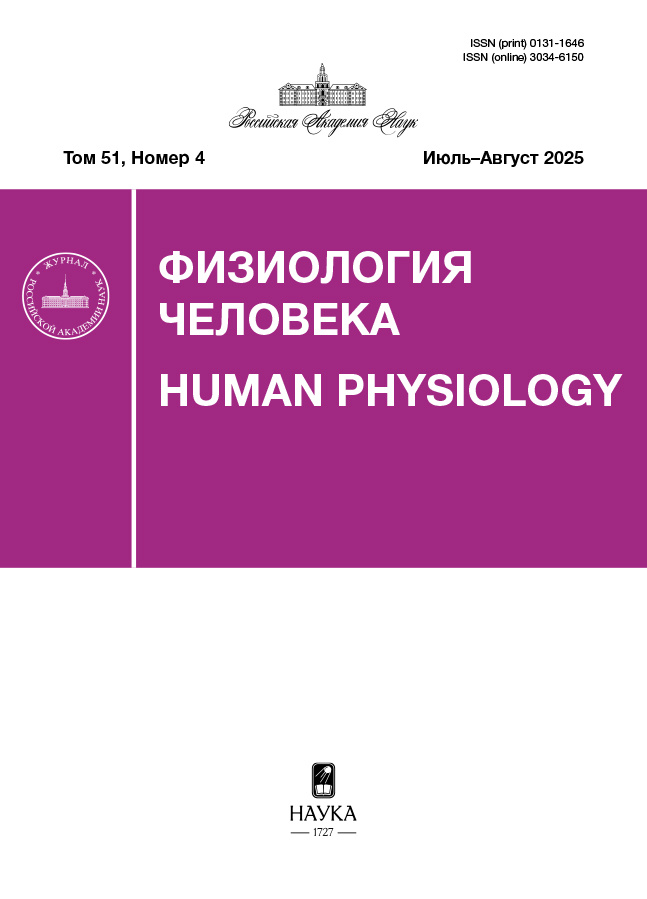Slow negative potentials associated with preparation period of memory-guided saccades and antisaccades in healthy individuals and subjects at clinical-high risk for schizophrenia
- Authors: Dzhem A.P.1, Pavlov A.V.2, Tomyshev A.S.1, Omelchenko M.A.1, Kaleda V.G.1, Slavutskaya M.V.1,2, Lebedeva I.S.1
-
Affiliations:
- Mental Health Research Center
- Moscow State University
- Issue: Vol 51, No 3 (2025)
- Pages: 28-39
- Section: Articles
- URL: https://transsyst.ru/0131-1646/article/view/684022
- DOI: https://doi.org/10.31857/S0131164625030034
- EDN: https://elibrary.ru/TRWGMH
- ID: 684022
Cite item
Abstract
The concept of clinical-high risk (CHR) for schizophrenia implies the possibility of identifying a potential predisposition to future schizophrenia manifestation. An important goal of biological psychiatry is conducting research aimed at understanding the neurophysiological mechanisms of this condition. In this study, saccade characteristics of patients at CHR for schizophrenia (n = 15) and healthy participants (n = 15), as well as parameters of their slow negative potentials in the one-second interval preceding the signal to perform a saccade in a “memory-guided saccades/antisaccades” paradigm were analyzed. 12 participants from the CHR group also underwent magnetic resonance imaging (MRI) for subsequent comparison with the control group selected from the laboratory database. Saccade latencies and error rates were higher in the CHR group. There were also found lateral differences in CHR, but not in the control group. However, no between-group differences were observed in studied electrophysiological and MRI parameters. The obtained results may be interpreted as indirect signs of impairments in executive control, interhemispheric asymmetry and connectivity in the CHR group, although further studies are required to determine the possibility of using slow negative potentials parameters as clinical markers.
Full Text
About the authors
A. P. Dzhem
Mental Health Research Center
Author for correspondence.
Email: npjam@mail.ru
Russian Federation, Moscow
A. V. Pavlov
Moscow State University
Email: npjam@mail.ru
Russian Federation, Moscow
A. S. Tomyshev
Mental Health Research Center
Email: npjam@mail.ru
Russian Federation, Moscow
M. A. Omelchenko
Mental Health Research Center
Email: npjam@mail.ru
Russian Federation, Moscow
V. G. Kaleda
Mental Health Research Center
Email: npjam@mail.ru
Russian Federation, Moscow
M. V. Slavutskaya
Mental Health Research Center; Moscow State University
Email: npjam@mail.ru
Russian Federation, Moscow; Moscow
I. S. Lebedeva
Mental Health Research Center
Email: npjam@mail.ru
Russian Federation, Moscow
References
- Enderle J.D. Neural control of saccades // Prog. Brain Res. 2002. V. 140. P. 21.
- Herwig A., Beisert M., Schneider W.X. On the spatial interaction of visual working memory and attention: Evidence for a global effect from memory-guided saccades // J. Vis. 2010. V. 10. № 5. P. 8.
- Yung A.R., McGorry P.D., McFarlane C.A. et al. Monitoring and care of young people at incipient risk of psychosis // Schizophr. Bull. 1996. V. 22. № 2. P. 283.
- Kleineidam L., Frommann I., Ruhrmann S. et al. Antisaccade and prosaccade eye movements in individuals clinically at risk for psychosis: Comparison with first-episode schizophrenia and prediction of conversion // Eur. Arch. Psychiatry Clin. Neurosci. 2019. V. 269. № 8. P. 921.
- Obyedkov I., Skuhareuskaya M., Skugarevsky O. et al. Saccadic eye movements in different dimensions of schizophrenia and in clinical high-risk state for psychosis // BMC Psychiatry. 2019. V. 19. № 1. P. 110.
- Schurger A., Hu P. 'Ben', Pak J., Roskies A.L. What Is the Readiness Potential? // Trends Cogn. Sci. 2021. V. 25. № 7. P. 558.
- Van Der Stigchel S., Heslenfeld D.J., Theeuwes J. An ERP study of preparatory and inhibitory mechanisms in a cued saccade task // Brain Res. 2006. V. 1105. № 1. P. 32.
- Walter W.G., Cooper R., Aldridge V.J. et al. Contingent Negative Variation: An Electric Sign of Sensori-Motor Association and Expectancy in the Human Brain // Nature. 1964. V. 203. № 4943. P. 380.
- Klein C., Heinks T., Andresen B. et al. Impaired modulation of the saccadic contingent negative variation preceding antisaccades in schizophrenia // Biol. Psychiatry. 2000. V. 47. № 11. P. 978.
- Tomyshev A.S., Lebedeva I.S., Akhadov T.A. et al. Alterations in white matter microstructure and cortical thickness in individuals at ultra-high risk of psychosis: A multimodal tractography and surface-based morphometry study // Psychiatry Res. Neuroimaging. 2019. V. 289. P. 26.
- Liloia D., Brasso C., Cauda F. et al. Updating and characterizing neuroanatomical markers in high-risk subjects, recently diagnosed and chronic patients with schizophrenia: A revised coordinate-based meta-analysis // Neurosci. Biobehav. Rev. 2021. V. 123. P. 83.
- Dudina A.N., Tomyshev A.S., Omelchenko M.A. et al. [Structural features of the brain in individuals with youth depression at a clinical risk for psychosis] // Zh. Nevrol. Psikhiatr. Im. S.S. Korsakova. 2023. V. 123. № 6. P. 94.
- Mento G. The role of the P3 and CNV components in voluntary and automatic temporal orienting: A high spatial-resolution ERP study // Neuropsychologia. 2017. V. 107. P. 31.
- Duma G.M., Granziol U., Mento G. Should I stay or should I go? How local-global implicit temporal expectancy shapes proactive motor control: An hdEEG study // NeuroImage. 2020. V. 220. P. 117071.
- Omelchenko M.A. [Negative symptoms at the prodromal stage of schizophrenia at a young age (current problems of diagnostics and treatment)] // V.M. Bekhterev Review of Psychiatry and Medical Psychology. 2019. № 4–2. P. 41.
- Hikosaka O., Wurtz R.H. Visual and oculomotor functions of monkey substantia nigra pars reticulata. III. Memory-contingent visual and saccade responses // J. Neurophysiol. 1983. V. 49. № 5. P. 1268.
- Fischl B. FreeSurfer // NeuroImage. 2012. V. 62. № 2. P. 774.
- Desikan R.S., Ségonne F., Fischl B. et al. An automated labeling system for subdividing the human cerebral cortex on MRI scans into gyral based regions of interest // NeuroImage. 2006. V. 31. № 3. P. 968.
- Gnezditsky V.V. [Evoked Brain Potentials in Clinical Practice]. Taganrog: TRTU Publishing House, 1997. 252 p.
- Ettinger U., Kumari V., Chitnis X.A. et al. Volumetric Neural Correlates of Antisaccade Eye Movements in First-Episode Psychosis // Am. J. Psychiatry. 2004. V. 161. № 10. P. 1918.
- Ekin M., Akdal G., Bora E. Antisaccade error rates in first-episode psychosis, ultra-high risk for psychosis and unaffected relatives of schizophrenia: A systematic review and meta-analysis // Schizophr. Res. 2024. V. 266. P. 41.
- Camchong J., Dyckman K.A., Austin B.P. et al. Common neural circuitry supporting volitional saccades and its disruption in schizophrenia patients and relatives // Biol. Psychiatry. 2008. V. 64. № 12. P. 1042.
- Liu W., Cai X., Chang Y. et al. Structural abnormalities in the Fronto-Parietal Network: Linking white matter integrity to sustained attention deficits in Schizophrenia // Brain Res. Bull. 2023. V. 205. P. 110818.
- Amador X.F., Malaspina D., Sackeim H.A. et al. Visual fixation and smooth pursuit eye movement abnormalities in patients with schizophrenia and their relatives // J. Neuropsychiatry Clin. Neurosci. 1995. V. 7. № 2. P. 197.
- Sklar A.L., Coffman B.A., Salisbury D.F. Localization of early-stage visual processing deficits at schizophrenia spectrum illness onset using magnetoencephalo-graphy // Schizophr. Bull. 2020. V. 46. № 4. P. 955.
- Gold J.M., Luck S.J. Working Memory in People with Schizophrenia // Curr. Top. Behav. Neurosci. 2022. V. 63. P. 137.
- Spagna A., Kim T.H., Wu T., Fan J. Right hemisphere superiority for executive control of attention // Cortex. 2020. V. 122. P. 263.
- Barrett G., Shibasaki H., Neshige R. Cortical potentials preceding voluntary movement: Evidence for three periods of preparation in man // Electroencephalogr. Clin. Neurophysiol. 1986. V. 63. № 4. P. 327.
- Kukleta M., Lamarche M. The early component of the premovement readiness potential and its behavioral determinants // Cogn. Brain Res. 1998. V. 6. № 4. P. 273.
- Kirenskaya A.V., Myamlin V.V., Novototsky-Vlasov V.Y. et al. The contingent negative variation laterality and dynamics in antisaccade task in normal and unmedicated schizophrenic subjects // Spanish J. Psychol. 2011. V. 14. № 2. P. 869.
- Tseng P., Chang C.F., Chiau H.Y. et al. The dorsal attentional system in oculomotor learning of predictive information // Front. Hum. Neurosci. 2013. V. 7. P. 404.
- Beck V.M., Vickery T.J. Oculomotor capture reveals trial-by-trial neural correlates of attentional guidance by contents of visual working memory // Cortex. 2020. V. 122. P. 159.
- Jonikaitis D., Noudoost B., Moore T. Dissociating the contributions of frontal eye field activity to spatial working memory and motor preparation // J. Neurosci. 2023. V. 43. № 50. P. 8681.
- Yokoyama O., Nishimura Y. Preselection of potential target spaces based on partial information by the supplementary eye field // Commun. Biol. 2024. V. 7. № 1. P. 1215.
- Jones D.T., Graff-Radford J. Executive Dysfunction and the Prefrontal Cortex // Continuum Lifelong Learning in Neurology. 2021. V. 27. № 6. P. 1586.
- Yang G., Wu H., Li Q. et al. Dorsolateral prefrontal activity supports a cognitive space organization of cognitive control // eLife. 2024. V. 12. P. RP87126.
- Numssen O., Bzdok D., Hartwigsen G. Functional specialization within the inferior parietal lobes across cognitive domains // eLife. 2021. V. 10. P. e63591.
- Andersen R.A., Cui H. Intention, action planning, and decision making in parietal-frontal circuits // Neuron. 2009. V. 63. № 5. P. 568.
- Talanow T., Kasparbauer A.M., Lippold J.V. et al. Neural correlates of proactive and reactive inhibition of saccadic eye movements // Brain Imaging Behav. 2020. V. 14. № 1. P. 72.
- Osborne K.J., Zhang W., Farrens J. et al. Neural mechanisms of motor dysfunction in individuals at clinical high-risk for psychosis: Evidence for impairments in motor activation. // J. Psychopathol. Clin. Sci. 2022. V. 131. № 4. P. 375.
- Di Russo F., Berchicci M., Bianco V. et al. Normative event-related potentials from sensory and cognitive tasks reveal occipital and frontal activities prior and following visual events // NeuroImage. 2019. V. 196. P. 173.
- Schneider D., Zickerick B., Thönes S., Wascher E. Encoding, storage, and response preparation — Distinct EEG correlates of stimulus and action representations in working memory // Psycho-physiology. 2020. V. 57. № 6. P. e13577.
- Reilly J.L., Lencer R., Bishop J.R. et al. Pharmacological treatment effects on eye movement control // Brain Cogn. 2008. V. 68. № 3. P. 415.
- Wen M., Dong Z., Zhang L. et al. Depression and Cognitive Impairment: Current Understanding of Its Neurobiology and Diagnosis // Neuropsychiatr. Dis. Treat. 2022. V. 18. P. 2783.
Supplementary files










